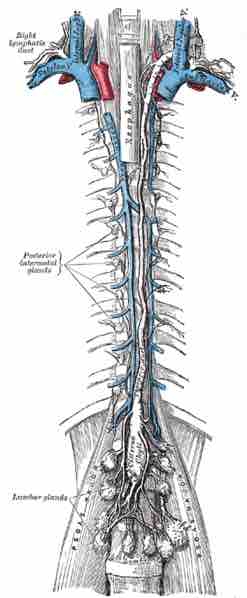After filtration by the lymph nodes, efferent lymphatic vessels take lymph to the end of the lymphatic system. The final goal of the lymphatic system is to recirculate lymph back into the plasma of the bloodstream. There are two specialized lymphatic structures at the end of the lymphatic system, called the lymph trunks and ducts.
Lymphatic Trunks
A lymphatic trunk is any large lymph vessel that forms from the convergence of many efferent lymph vessels. There are four sets of of lymph trunks that are paired with a right and left half, and one unpaired trunk:
- Jugular lymph trunks, located in the neck, drain lymph fluid from the cervical lymph nodes of the neck.
- Subclavian lymph trunks, located beneath the clavicle, drain lymph fluid from the apical lymph nodes around the armpit, which carry lymph from the arms.
- Bronchomediastinal lymph trunks, located in the chest, drain lymph fluid from the lungs, heart, trachea, mediastinal, and mammary glands.
- Lumbar lymph trunks are the lower pair of lymph trunks that drain lymph fluid from the legs, pelvic region, and kidneys.
- Intestinal lymph trunk is the unpaired lymph trunk that receives chyle (lymph mixed with fats) from the intestines. Chyle typically has a high fatty acid content.
Lymphatic trunks then drain lymph fluid into the lymph ducts, the final part of the lymphatic system.
Lymph Ducts
Two lymph ducts receive lymph from the lymph trunks. These are the largest lymph vessels and contain three layers, similar to those of great veins.
- The thoracic lymph duct, the largest lymph vessel in the body, takes lymph from the lower and left halves of the body. Because the thoracic lymph duct drains the intestinal lymph trunks, it carries a mixture of lymph and emulsified fatty acids called chyle back to the bloodstream.
- The right lymphatic duct receives lymph from the right and upper halves of the body, including the right sides of the jugular, bronchomediastinal, and subclavian lymph trunks.
The thoracic duct drains into to the left subclavian vein while the right duct drains into the right subclavian vein, both at the junction between the respective vein and the jugular vein. The two subclavian veins then merge into the vena cava, the large vein that brings deoxygenated blood to the heart. The lymph ducts each have internal valves at their junction with the subclavian vein. These function similarly to other lymphatic valves and prevent venous blood from flowing into the lymph duct. This point marks the end of lymph fluid's journey through the lymphatic system.

Lymphatic Ducts
The thoracic duct and right lymphatic duct.